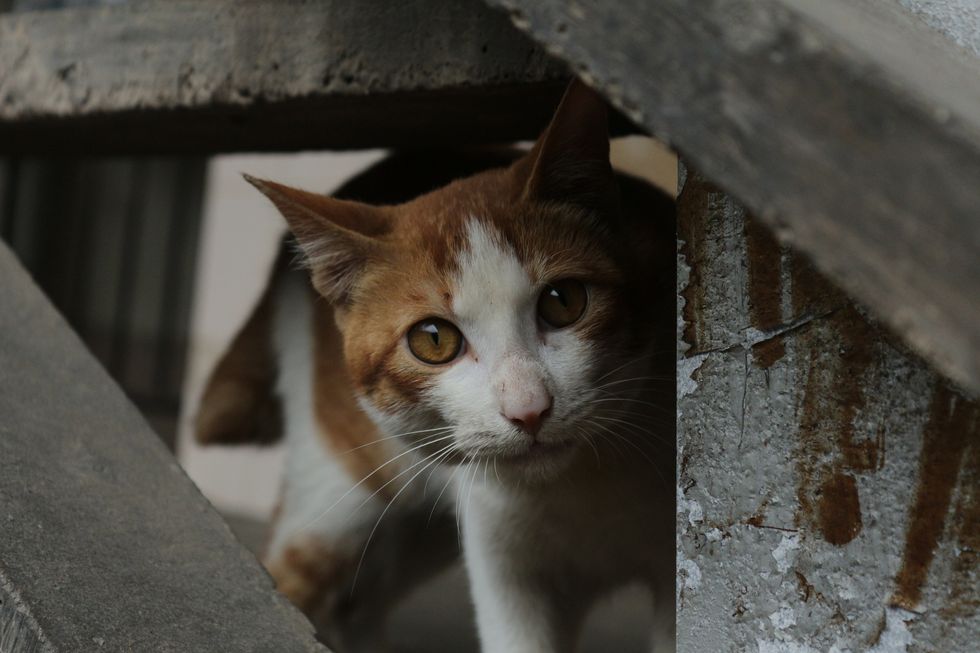You've probably seen them at one point or another. Whether they're adorably lounging around, springing from a bush or darting off when you come too close.
How exactly did they get there? Strays are house cats that lost their homes through abandonment or escape but notably have trusted humans. Their offspring are considered feral, which exhibit wild tendencies. Living without designated human contact, they tend to be unsocialized and instinctively avoid people. There are 30 to 40 million of those in the US.
If you have seen such cats, you might have noticed they are always in the same place. Litters tend to form colonies, and bonding amongst them is common. Establishing a managed colony creates a centralized location where they tend to linger around since hunting food is no longer a necessity. Usually, it's because they have a volunteer human caretaker.
Feral cats have a shorter lifespan than their domesticated counterparts. Half of the kittens will not survive their first year. And if they do, their lifespan is about two years because of unmanaged, harsh living conditions. Starvation, infections, diseases, and parasites are a few of the challenges. But with human caretakers, their lives can be up to ten years or more – like a house cat.
Normally these mischievous beings find food through scavenging. Dietary studies observed digesting garbage and scraps in particular. However, unsanitary sources and human products can damage their intestines. Other means are hunting birds and rodents, but that is not a reliable food supply depending on their region. Malnourishment is another of the many obstacles these beings have to combat.
There are numerous ways to get involved, not only for their sake but for the community as a whole. One is by providing low-cost cat food. Store brands are under $1 for a single wet food can or multiple servings in dry food bags. Tap water in clean BPA-free bowls is best because older animals cannot digest milk and estimating ages is difficult. Winter and summer months are the extremes, leaving them the most vulnerable. Anything from a towel to cardboard box can provide comfort and keep their coats clean.
There has yet to be an agreement of when the best time to integrate cats with humans is, but time is certainly crucial. The sooner a cat is adopted or fostered, the better. As each day goes on, humans seem scarier, just giants towering over their fearful bodies. Estimates for the window have been put up to four months because kittens are still familiarizing themselves with the world.
Community cats can become socialized at any age. Time, effort and patience are crucial because rarely is this immediate. Consistent feedings are integral to gaining their trust because they associate you with food. A bond of trust forms through fulfilling their needs. With increments, they can go from running away to lowering their guard. Behaviors can be as subtle as eating within your presence or calmly approaching you for food.
While progressive cats may remain in your presence, upon the appearance of someone new, they may still depart. Do not let that deter your efforts. Trusting one human is the road to everyone eventually. More successful steps are cats welcoming your touch. In kittens, a "burrito" can be done to expedite this process by clutching them with a towel. Chances are possible that matured feral cats can be fostered and taken in as house pets too.
However, it is important to be realistic. Other cats may never warm up to humans. That does not mean they are dangerous or bad apples, only that they prefer outer environments. Feral cats are territorial and connected to their colonies. Just as sirens would shock a house cat, towering walls in a small space can cause them distress. Separating bonded pairs can have the same impact.
Feral cats have roamed for a while, but it was not until the 1990s when attention substantially turned to them. The Alley Cat Allies created a network and legitimized the current Trap-Neuter-Return organization. TNR's nonlethal programs expanded and exist throughout the country. Offering free civilian training, anyone can make a difference.
TNR teaches a routine process, completed with 7 steps. Individuals learn to trap a cat, typically with cages and food lures inside. Through alliances, certified individuals then get the cats spayed/neutered and vaccinated at partnered local veterinarian clinics. This can be done at discounted costs or for free. Afterwards, the vet ear-tips them (see below). Painless and risk-free, this works as a universal sign announcing the cat has been looked after and should not be trapped again. Kittens and friendly cats are put up for adoption, while the seasoned and timid are returned to their colonies.
The operating mission behind TNR is to control the feral population, allow cats humane conditions and counteract rodents. Cancer risks decrease and typical nuisance behaviors such as yowling and fighting cease. Just 2% of the community cat population has been spayed/neutered compared to the 85% of house cats. 80% of cat births are from community cats, causing unchecked population growth. Without new kittens being born, the colonies will humanely decrease.
Studies have shown that new feral cats are less likely to move into neighborhoods with existing TNR cats, proving order for everyone. TNR is good for the present and long-term. The ASPCA supports TNR, describing it as humane and effective. Successful cities boost up to a 97% live release rate and it is cost-effective. Without TNR, the cats may go to crowded animal shelters. Community cats there are largely euthanized,with the number being in the millions yearly.
Letting cats live outdoors may seem unideal, but forced housing is unfair to unsocialized cats. The cats are only released back if they are well and independently functional. Especially compared to other rougher, failed alternative methods, TNR is the kindest. Among those were refusing to feed them or removing them only to have a "vacuum effect" occur: new cats move in for the same reason the previous cats existed. At the extreme, "catch and kill" policies were used by animal control.
Cats have coincided with humans for quite a while, roughly 10,000-12,000 years. But not in the way that is seen today. Keeping cats solely indoors is a revelation only applied 60 years ago. The idea of a cat only being inside all day was an impossible idea at the turn of the 20th century. This changed because of commercial house cat products, such as canned food offering high protein, and litter boxes. Before, house cats were integrated with the outdoors and were not the indoor pets seen in funny YouTube videos.
These outdoor fur balls give back to the community in their own special, ecological way. A detrimental and common misconception is that feral cats are bad for other wildlife. Ecologists have proven that is false. Studies observed that removing feral cats do not save other species, and can cause a dire chain of events. The cats reduce rat and mice population. Without the feral cats, the bird population would be decimated because of the increased rodents and other burrowing species.
Feral cats are not a risk to human health. That is a core misconception which harms the already vulnerable felines. This misplaced fear and hysteria has caused not only a prejudice but birthed "catch and kill" policies. The Boston Public Health Commission stated that it is uncommon for people to become ill through interacting with them (known as zoonotic diseases, from animal to human). Feral cats rarely come into direct contact with humans like a house cat, and when unprovoked they are harmless.
Misinformation kills community cats every day. Even if you do not want to get involved, it is important to be educated on them to avoid any misconceptions. Feral cats just want to live like anyone else and are for the most part hidden and gentle. Consider them a fluffy member.









 Photo by
Photo by  Photo by
Photo by  Photo by
Photo by  Photo by
Photo by 


 people sitting on chair in front of computer
people sitting on chair in front of computer



 all stars lol GIF by Lifetime
all stars lol GIF by Lifetime two women talking while looking at laptop computerPhoto by
two women talking while looking at laptop computerPhoto by  shallow focus photography of two boys doing wacky facesPhoto by
shallow focus photography of two boys doing wacky facesPhoto by  happy birthday balloons with happy birthday textPhoto by
happy birthday balloons with happy birthday textPhoto by  itty-bitty living space." | The Genie shows Aladdin how… | Flickr
itty-bitty living space." | The Genie shows Aladdin how… | Flickr shallow focus photography of dog and catPhoto by
shallow focus photography of dog and catPhoto by  yellow Volkswagen van on roadPhoto by
yellow Volkswagen van on roadPhoto by  orange i have a crush on you neon light signagePhoto by
orange i have a crush on you neon light signagePhoto by  5 Tattoos Artist That Will Make You Want A Tattoo
5 Tattoos Artist That Will Make You Want A Tattoo woman biting pencil while sitting on chair in front of computer during daytimePhoto by
woman biting pencil while sitting on chair in front of computer during daytimePhoto by  a scrabbled wooden block spelling the word prizePhoto by
a scrabbled wooden block spelling the word prizePhoto by 
 StableDiffusion
StableDiffusion
 StableDiffusion
StableDiffusion
 StableDiffusion
StableDiffusion

 women sitting on rock near body of waterPhoto by
women sitting on rock near body of waterPhoto by 








